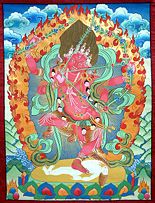Kurkulla, Kurukulla or Red Tara is a Tibetan fierce red form of Tara, the goddess of witchcraft, dominator of all beings through control of the power of passion.
Etymology
Kurukulla is translated into Tibetan as Rigjyedma (rig-byed-ma), she who is the cause knowledge.
Description
Kurukulla with four arms dances on the prostrate body of the demon Rahu (ignorance). Her bow and arrow pierce through difficulties, her lower right hand offers the abayah mudra of reassurance. Her mala of skulls shows she is the Tibetan form of Kali, she who transforms death to life, wrath to auspiciousness.
Red Tara also adopts the attributes of Kama, the Indian Cupid, and strikes the hearts of egocentric beings with her flower arrows, just as he does. Her red color connotes the function of bringing people under one’s power, of enchanting, bewitching, attracting, subjugating, magnetizing them.
Function
Kurukulla has become the Buddhist goddess of love and sex, corresponding to the Western goddesses Aphrodite and Venus. She is depicted as a voluptuous and seductive nude sixteen year old girl. Among the attributes she holds in her four hands, four arms being her most common manifestation, are the flower-entwined bow and arrow, reminiscent of the Western Eros and Cupid, although as the goddess of witchcraft, she is more akin to Diana.
A text like the Arya Tara Kurukulla Kalpa contains many ritual practices of lower magic to accomplish specific goals, for example:
- amulets for enchanting and bringing others under one’s power,
- spells to frighten away poisonous snakes,
- methods for a dissatisfied wife to subjugate her husband,
- amulets for protection from evil spirits and bad luck,
- spells for acquiring wealth and gaining power,
- the use of cowrie shells in divination and ritual,
- divinations to find a treasure,
- methods for walking on water,
- methods to avoid getting gray hair,
- cures for frigidity and impotence.
In one Kurukulla Sadhana found in the Sadhanamala (No. 72), there occurs a list of eight great siddhis or magical powers acquired through her practice:
- Khadga-siddhi (ral-gri), the power to be invincible in battle with a sword (khadga);
- Anjana-siddhi (mig-rtsi), the power to remove ordinary lack of sight by using a magical ointment that enables the user to see Devas, Nagas, and other spirits;
- Padalepa-siddhi (rkang-pa’i byug-pa), the power to be swift of foot by using a magical ointment that, when applied to the feet, allows the user to run with incredible swiftness;
- Antardhana-siddhi (mi snang-bar ‘gyur-ba), the power to become invisible;
- Rasayana-siddhi (bcud-len), the power of rejuvenation and long life through obtaining the elixir of life by way of an alchemical process;
- Khechara-siddhi (mkha’-spyod), the power to levitate or to fly through the sky;
- Bhuchara-siddhi (zhing-spyod), the power to move freely through the earth, mountains, and solid walls; and
- Patala-siddhi (sa-‘og), the power to have command over the spirits of the underworld (patala).

